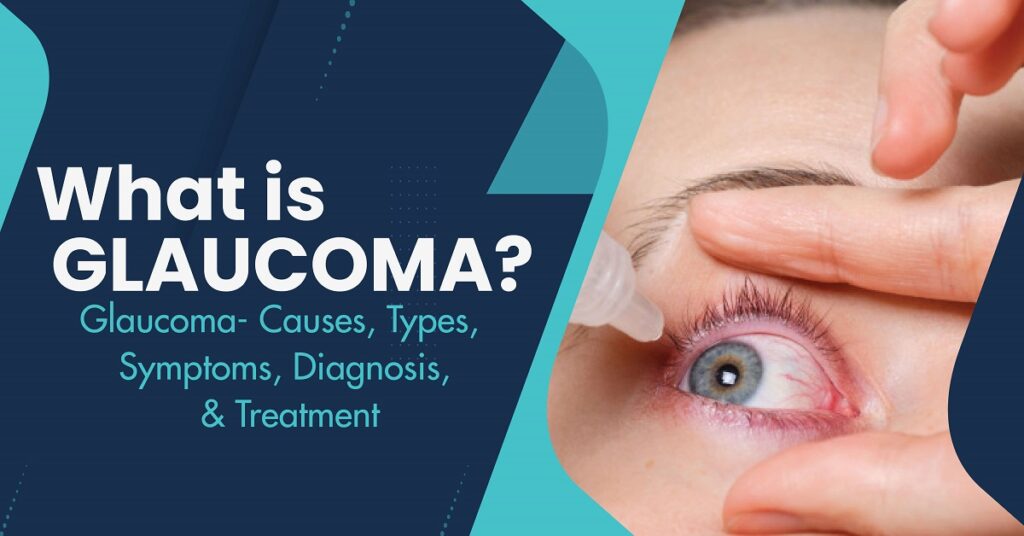Glaucoma is an eye disease that is related to eye disorders. Let’s have a look at a brief description of glaucoma, its types, causes, symptoms, diagnosis, and treatment.
What is Glaucoma?
Glaucoma is related to eye problems. It’s generally a group of eye disorders, it is a complex disease that can damage the optic nerve and can lead to loss of vision. In most cases of glaucoma, fluid material builds up in the front part of the eye. Then this extra fluid puts pressure on the eye, which sends images to your brain. If the damage worsens, it gradually damages the optic nerve. This pressure is called IOP which means intraocular pressure, or eye pressure.
In some cases, people have normal eye pressure and still get glaucoma. Untreated or poorly controlled glaucoma can lead to irreversible and permanent vision loss or even total blindness within a few years.
Most people with glaucoma don’t show early symptoms or any pain. It’s a good habit to visit your ophthalmologist regularly so that they can diagnose and treat glaucoma before you have long-term vision loss.
If you lose vision due to any disorder, it can’t be brought back. But if you have lowering eye pressure then they can help you to keep the sight you have. Most people with glaucoma who follow their treatment plan and have regular eye check-ups can keep their vision.
What are the Types of Glaucoma?
There are various types of glaucoma. Each type of glaucoma is different from the others, but most of them have no early symptoms or no post symptoms, so it’s important to get tested regularly, especially if you are at higher risk.
Primary Glaucomas:
When the doctors are unable to find out which causes a type of glaucoma, that type is called primary glaucoma.
- Open-angle glaucoma: Open-angle glaucoma is the most common type of glaucoma according to the National Eye Institute (NEI). It can be called chronic or primary glaucoma also. It doesn’t show any signs or symptoms except gradual vision loss over time. The vision loss may be so slow that your vision may suffer irreparable damage.
-
- Treatments: Laser treatment, surgery, medicines
- Normal-tension glaucoma: It is also known as low-pressure glaucoma. It is also a rare type of glaucoma in which you have blind spots in your vision and your eye pressure isn’t above the normal range but still causes damage to the eye that affects the optic nerve. Many experts believe that this too is like open-angle glaucoma.
-
- Treatments: Laser treatment, surgery, medicines
- Angle-closure glaucoma: It is also called narrow-angle glaucoma or acute angle glaucoma. In this sort of glaucoma, the fringes of the iris (the colored part of your eye) block fluid from draining out of the front of the eye. The fluid builds up quickly, causing an increase in eye pressure. If it’s not treated, acute glaucoma can cause blindness in only a couple of days.
-
- Treatments: Laser treatment, medicines
- Congenital glaucoma: Congenital glaucoma is not common it is a very rare inherited condition almost 1 in 10,000, that develops due to the incomplete or faulty development of the drainage canals of the eye. It’s mainly a type of disease that occurs in infants and young children due to abnormal development of the drainage angle of the eye. It encompasses a heterogeneous group of diseases.
-
- Treatments: Surgery, medicines
Secondary Glaucomas:
Many times glaucoma is caused by some other medical condition then this is called secondary glaucoma.
- Neovascular glaucoma: Neovascular glaucoma occurs when the eye makes extra blood vessels that cover the part of your eye where fluid would normally drain out. It’s mainly caused by another medical condition, like diabetes or high blood pressure. This kind of glaucoma is hard to treat. Doctors firstly have to treat the underlying cause (like diabetes or high blood pressure) and then use glaucoma treatments to lower the eye pressure that results from it.
-
- Treatments: Laser treatment, surgery, medicines
- Pigmentary glaucoma: Pigment dispersion syndrome or pigmentary glaucoma happens when the color from your iris (the colored part of your eye) flakes off. This loose pigment can block the fluid from draining out of your eye, which may further increase your eye pressure and can cause pigmentary glaucoma. Doctors may treat it by lowering the eye pressure, but it isn’t a proper way to prevent pigment from detaching from the iris.
-
- Treatments: Laser treatment, surgery, medicines
- Exfoliation glaucoma: Exfoliation glaucoma or may be called pseudoexfoliation glaucoma happens in those people most of the time who having exfoliation syndrome, a condition that causes extra material to detach from parts of the eye and block fluid from draining out. This kind of glaucoma can progress faster than primary chronic glaucoma or open-angle glaucoma and sometimes causes higher eye pressure. This means that it is very important for people that are at risk to get eye check-ups regularly.
-
- Treatments: Laser treatment, surgery, medicines
- Uveitic glaucoma: Uveitic glaucoma can happen in those people who have uveitis, a disorder type that causes irritation and swelling in the eye. About 2 in 10 people with uveitis disease will develop uveitic glaucoma. Uveitis can cause inflammation and connective tissue in the middle of the eye. This might damage or block the part of the eye where fluid drains out, causing high eye pressure and resulting in uveitic glaucoma.
-
- Treatments: Surgery, medicines
What are the causes of Glaucoma?
The back part of the eye continuously makes a transparent fluid which is called aqueous humor. As this fluid is formed, it fills the front part of your eye. Then, it leaves the part through the channels in the cornea and iris. If these channels are blocked or partially obstructed, it puts the natural pressure in your eye, which is named intraocular pressure (IOP), may increase. As your intraocular pressure increases, it may have the chance to damage your optic nerve. As damage to your nerve progresses, you’ll begin losing sight of your eye.
Abnormally high pressure within the eye i.e. intraocular pressure is sometimes higher, but not always, associated with optic nerve damage. When the pressure inside the eye increases this is due to the eye’s fluid drainage system fails to function properly.
- Chronic glaucoma or open-angle glaucoma – In this, the blockage of the eye’s drainage channels occurs gradually. It’s the foremost common form and is painless
- Acute angle glaucoma – In this, the blockage in the drainage channels of the eye occurs suddenly. It’s painful and may end in permanent vision loss if not treated immediately.
There are different kinds of glaucoma, with a variety of characteristics and causes. Some of these include:
- Primary chronic glaucoma – a partial blockage in the eye’s drainage system causes fluid to drain out of the eye too slowly, resulting in a gradual increase in pressure within the eye
- Angle-closure glaucoma or Narrow-angle glaucoma– In this type, glaucoma occurs when the iris bulges and blocks the drainage system, causing inadequate fluid drainage and an increase in intraocular pressure
- Normal-tension glaucoma – the optic nerve becomes damaged although the pressure within the eye remains normal. The reason is unclear but could be due to a scarcity of blood flow to the optic nerve.
- Congenital glaucoma – this occurs in infants and children and usually without symptoms
- Pigmentary glaucoma – pigment granules within the eye build up and block drainage channels.
Glaucoma tends to run in families. Recent studies have found sort of genetic variations in human DNA that each contribute a small amount to intraocular pressure and which could predict whether someone might develop glaucoma with 75% accuracy.
What are the glaucoma symptoms?
Both Open-Angle Glaucoma and Acute Angle-Closure glaucoma have completely different symptoms. Symptoms of glaucoma are:
- Symptoms of Open-Angle Glaucoma: The various symptoms of open-angle glaucoma include-
- Peripheral vision, usually in both eyes, is lost gradually (characterized by the development of patchy blind spots)
- Advanced stages are characterized by tunnel vision.
- Symptoms of Acute Angle-Closure Glaucoma: The various symptoms of acute angle glaucoma include –
- Pain in the eye, which may be accompanied by nausea and vomiting
- Sudden development of visual disturbance
- Blurred vision
- Seen Halos (i.e. crowns or auras) lights
- Reddening of the eye
- Severe headaches
- Unexpected vision problems, especially in poor lighting.
Regular eye checkups are very important to detect glaucoma in the early stages to successfully treat it and prevent further progression.
How is glaucoma diagnosed?
Glaucoma can be diagnosed by regular eye checkups. If it can be diagnosed early then glaucoma can be properly managed to prevent major loss. Here are the 6 steps used to help detect glaucoma.
- Tonometry: Tonometry is a common test used to measure the pressure inside the eye which is intraocular pressure (IOP). It is a measurement of determining whether you have glaucoma or not. Or it is not treated in time, it will lead to vision loss.
- Ophthalmoscopy: Ophthalmoscopy is a diagnostic test that is used to examine the inside of the eye. Ophthalmoscopy is performed on a dilated or undilated eye. an eye doctor uses special magnifying lenses and medical devices to look at the optic nerve. The color, shape, and overall health of the optic nerve are vital in glaucoma assessment. The doctor can also use a photographic camera to photograph the optic nerve.
- Gonioscopy: Gonioscopy is also a diagnostic test that uses a special mirrored device to gently touch the surface of the eye to look at the angle where the cornea meets the iris. Whether this angle is open or closed can tell the doctor what sort of glaucoma is present, and the way severe glaucoma could also be. Gonioscopy can also be done by using optical coherence tomography.
- Visual Field Testing: It is also known as perimetry, is a test that is used to diagnose glaucoma that measures how sensitive a person’s vision is. In perimetry or visual field test, you’ll look straight ahead at a small light or any target and you will be asked to let the examiner know once you see a flashlight to the side in your sight. Visual field testing usually must be repeated several times before the doctor can make a valid assessment
- Nerve Fiber Analysis: Nerve fiber analysis is a newer method of glaucoma testing during which the thickness of the nerve fiber layer is measured. Thinner areas of the eye may indicate damage caused by glaucoma. This test is especially good for those patients who may be considered to be a glaucoma suspect and also to point out if a person’s glaucoma is progressively becoming worse.
- Pachymetry: Pachymetry is another test method used to measure the thickness of the cornea. Pachymetry is starting to play a huge role in glaucoma testing The thickness of the cornea seems to influence the pressure reading when tonometry is performed.
What is the treatment of Glaucoma?
Your treatment will largely depend upon the type of glaucoma you have. The most common type, primary open-angle glaucoma, is usually treated with eye drops. Laser treatment or surgery could also be offered if drops don’t help. Glaucoma treatment includes:
Medication or Eye drops: Medicines or eye drops are given in the treatment for glaucoma. Eye drops are prescribed to use 1 and 4 times every day. It is vital to use them as directed, although you haven’t noticed any problems with your vision. Your eyesight is at risk if you do not stick or follow the recommended treatment.
Laser treatment: Laser treatment is recommended when eye drops don’t work or improve your symptoms. This is where a high-energy beam of light is carefully aimed toward a part of your eye to prevent fluid from building up inside it. There are various laser treatments are available that includes:
- Laser Trabeculoplasty: The eye surgeon uses a laser in this treatment to make the drainage angle work better. In that way, fluid flows out properly into the eye and hence eye pressure is reduced.
- Cyclodiode Laser Treatment: In this treatment, the ophthalmologist uses a laser to lower the eye pressure drainage of a fluid called aqueous humor.
- Laser Iridotomy: In this treatment, the ophthalmologist uses a laser beam to create a tiny hole in the iris. This hole helps fluid flow to the drainage.
Surgery: Surgery is recommended when the medicines and laser treatment haven’t been effective. The most common form of surgery for glaucoma is named trabeculectomy. It involves removing a part of the eye-drainage tubes to allow fluid to drain more easily. Glaucoma surgery could also be carried out under local anesthetic that means while you’re awake or general anesthetic when you’re asleep.
FAQ (Frequently Asked Question):
Q. What are the risk factors?
Ans. There are so many risk factors few of them are:
- Having high eye pressure is also called intraocular pressure.
- Over the age of 60.
- Having certain medical problems such as diabetes, high blood pressure, heart disease, etc.
- Having a family history of glaucoma.
Q. Is glaucoma preventable?
Ans. Glaucoma is not curable. As with any vision, blindness that is lost can not be brought back but glaucoma can be prevented if it is diagnosed in the early stage.
Q. Is it possible to become blind with glaucoma?
Ans. Yes, sometimes glaucoma can cause blindness also but it is very rare, about 5% of glaucoma patients become blind. However, sight impairment is common and occurs in almost 10% of glaucoma patients.
Q. Can glaucoma be cured?
Ans. Glaucoma can be cured if it is recognized in the early stages, otherwise, treatment and regular checkups can help to slow down or prevent vision loss but the damage caused by glaucoma can not be reversed. It is treated by lowering the eye pressure i.e. lowering the intraocular pressure.
Q. If I am diagnosed with glaucoma, how often should I go for an eye check-up?
Ans. A normal person should go for eye check-ups once or twice in 2 years. But the glaucoma patients should go for regular eye check-ups of a minimum of twice a year. You should do a visual field test at least once every 12 months, and some assessment of your optic nerve health at least once every 12 months.









